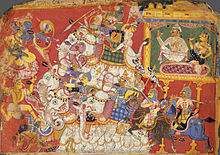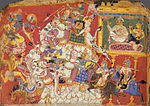
Varaha is an avatar of the Hindu god Vishnu, in the form of an Indian boar. Varaha is listed as third in the Dashavatara, the ten principal avatars of Vishnu.

The Kamakhya Temple at Nilachal hills in Guwahati, Assam is one of the oldest and most revered centres of Tantric practices, dedicated to the goddess Kamakhya. The temple is the center of the Kulachara Tantra Marga and the site of the Ambubachi Mela, an annual festival that celebrates the menstruation of the goddess. Structurally, the temple is dated to the 8th-9th century with many subsequent rebuildings—and the final hybrid architecture defines a local style called Nilachal. It is also one among the oldest 4 of the 51 pithas in the Shakta tradition. An obscure place of worship for much of history it became an important pilgrimage destination, especially for those from Bengal, in the 19th century during colonial rule.

Kamakhya, a mother goddess, is a Shakta Tantric deity; considered to be the embodiment of Kama (desire), she is regarded as the goddess of desire. Her abode–Kamakhya Temple is located in the Kamarupa region of Assam, India. Originally a Kirata goddess, Kamakhya remained outside Brahmanical influence until at least 7th century CE. Residing on Nilachal hills across the banks of the Brahmaputra river, west of Guwahati in the 10th/11th century Temple rebuilt in 1565 CE, she is worshiped in a non-iconic and un-anthropomorphic form of stone shaped like yoni fed by a perennial stream. The temple is primary amongst the 51 Shakti Pithas, and is one of the most important Shakta temples.
The Kalika Purana, also called the Kali Purana, Sati Purana or Kalika Tantra, is one of the eighteen minor Puranas (Upapurana) in the Shaktism tradition of Hinduism. The text was likely composed in Assam or Cooch Behar region of India and is attributed to the sage Markandeya. It exists in many versions, variously organized in 90 to 93 chapters. The surviving versions of the text are unusual in that they start abruptly and follow a format not found in either the major or minor Purana-genre mythical texts of Hinduism. Various types of animal sacrifices for devi are detailed in the Purana.

Kamarupa, an early state during the Classical period on the Indian subcontinent, was the first historical kingdom of Assam.

Satyabhama, also known as Satrajiti, is a Hindu goddess and the third queen consort of the Hindu god Krishna. Satyabhama is described as an incarnation of Bhumi, the goddess and the personification of the Earth. According to some traditions, she is regarded to have aided Krishna in defeating the asura Narakasura.
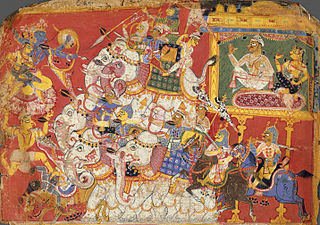
The Danava dynasty was the first legendary line of rulers in Pragjyotisha, established by Mahiranga Danava. The dynasty was of Kirata origin. These rulers are mentioned in the Kalika Purana but there are no archaeological evidence to support this.

The Bhauma dynasty is the second legendary dynasty of Pragjyotisha, after the Danava dynasty. Narakasura, who is said to have established this dynasty, and his descendants Bhagadatta and Vajradatta are first mentioned in the epics Mahabharata and the Ramayana in the sections that were composed in the first few centuries though they place them variously in either northwestern or eastern India. Narakasura's legend is further embellished in the locally composed Kalika Purana, the Yogini Tantra and local lores and the legends became firmly attached to Assam and North Bengal. The late embellishment of the Naraka legends point to legitimization of the three dynasties of the Kamarupa kings.
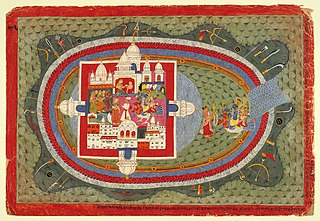
Pragjyotisha is a mythological kingdom that is mentioned in a multitude of Hindu epics. It came to be associated with the historical Kamarupa after Bhaskaravarman of the Varman dynasty by drawing his lineage from Naraka/Bhagadatta of the legendary Pragjyotisha to bring his peripheral kingdom closer to mainland traditions at a time when he was emerging as a powerful king with interests in North India. The identification with the mythical Naraka/Bhagadatta lineage continued to be used by the Mlechchhas and Palas for roughly similar purposes.
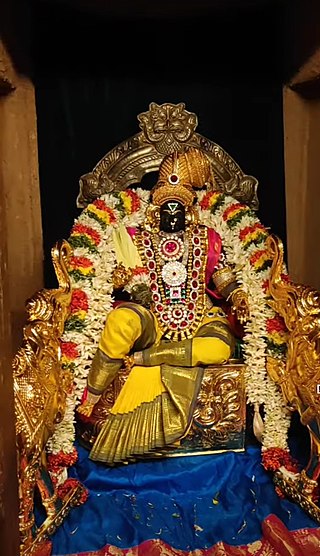
Bhumi, also known as Bhudevi and Vasundhara, is a Hindu goddess who is the personification of the earth. She is a consort of Varaha, an avatar of the deity Vishnu. According to Vaishnava tradition, she is the second aspect of Vishnu's consort, Lakshmi, along with the aspects of Sridevi and Niladevi. According to Hindu mythology, Varaha, the third avatar of Vishnu, saved her from the asura Hiranyaksha and later married her, making her one of his consorts. She is regarded as the mother of Narakasura, Mangala, and Sita.

Bhagadatta was the son of Narakasura, and the king of Pragjyotisha in Hindu mythology. Bhagadatta was born from a limb of the asura called Bashkala. He was a renowned warrior, and was known to be a great friend of Indra. When Arjuna embarked on a conquest to help his brother Yudhishthira perform the rajasuya yajna, Bhagadatta was one of the first kings to be conquered by him.

Pragjyotishpura or Pragjyotisapura, now deemed to be a region within modern Guwahati, was an ancient city and capital of the Varman dynasty. Though the earliest mention of Pragjyotisha in local sources come from the 7th century, the form was changed to Pragjyotishpura in the 9th century which describes it as the city of Naraka within Kamarupa. In Puranic text like the Ramayana, Pragjyotishpura is described as the fortress of Narakasura on mount Varaha located in the north-west of the Indian subcontinent in what is modern-day Punjab and Sindh.

The Ashtabharya or Ashta-bharya(s) is the group of eight principal queen-consorts of Hindu god Krishna, the king of Dvaraka, Saurashtra in the Dvapara Yuga (epoch). The most popular list, found in the Bhagavata Purana, includes: Rukmini, Jambavati, Satyabhama, Kalindi, Nagnajiti, Mitravinda, Lakshmana and Bhadra. Variations exist in the Vishnu Purana and the Harivamsa, which includes queens called Madri or Rohini, instead of Bhadra. Most of them were princesses.
Besides eight principal queens (Ashtabharya), the Hindu god Krishna, an avatar of the god Vishnu and the king of Dvaraka, wedded a number of captured women, whose number is mentioned as 16,000 or 16,108 in different scriptures.

Kamapitha is one of the four Kamarupa Pithas, the geographical divisions of ancient Kamarupa. Dineshchandra Sircar points out that these divisions are not found in the Kamarupa inscriptions and that they might be fabrications from late medieval sources, such as 16th-century work Yogini Tantra gives the boundaries of Kamapitha and other three pithas, the same work which gives boundaries of ancient Kamrup kingdom as well. The eastern border of Kamarupa was the temple of the goddess Tamreshvari near present-day Sadiya

Vajradatta is an asura king in Hindu mythology. He is the son and successor of King Bhagadatta, and the third ruler of the Naraka dynasty of the Pragjyotisha Kingdom. Vajradatta is regarded to have studied the four Vedas along with the discplines called the Angas, as well as the Nitishastras of Brihaspati and Shukra. Vajradatta is mentioned in epics as powerful as Indra, speedy like Vajra and who pleased the performer of hundred sacrifices, who is Indra again, in battle. He said to possess bolt-like lustre and conquered enemies like Indra.

Deepavali (transl. Diwali) is a 1960 Telugu-language Hindu mythological film, produced by K. Gopala Rao under the Aswaraja Pictures banner and directed by S. Rajinikanth. It stars N. T. Rama Rao and Savitri, with music composed by Ghantasala. This is third film of N. T. Rama Rao as Lord Krishna. The film is a box hit and celebrated 100 days, despite releasing only 6 days after Bhatti vikramarka. It was dubbed in 1974 in Kannada as Narakasura Vadhe,
Kecaikhati is a prominent goddesses from Northeast India. Her shrine is considered to be the Tamreswari Temple, near Paya in Arunachal Pradesh; and she is referred to as Dikkaravasini in the 9th century Kalika Purana whose temple formed the eastern limit of Kamarupa. But unlike Kamakhya and Kamakhya Temple, which acquired Brahmin priests and became associated with the legendary Narakasura and the historical Kamarupa kings, Kecaikhati continued to remain outside the ambit of Brahminical influence and remained under the control of Deori priests during the time of the Chutia kingdom and after up to the present time.

Mura was a very powerful asura (demon) mentioned in Hindu scriptures, who served as a general in Narakasura's army. Narakasura was the evil demon King of Pragjyotisha, and Mura along with his daughter Ahilavati played an important role in defending the Kingdom of Pragjyotisha from invaders.
